Washington showcases some of the most spectacular day hiking in the Pacific Northwest, combining dramatic mountain vistas, pristine alpine lakes, thundering waterfalls, and ancient forests.
From the granite peaks of the North Cascades to Olympic National Park, each day hike delivers a unique experience with something for every skill level.
1. Blue Lake Trail – North Cascades Highway
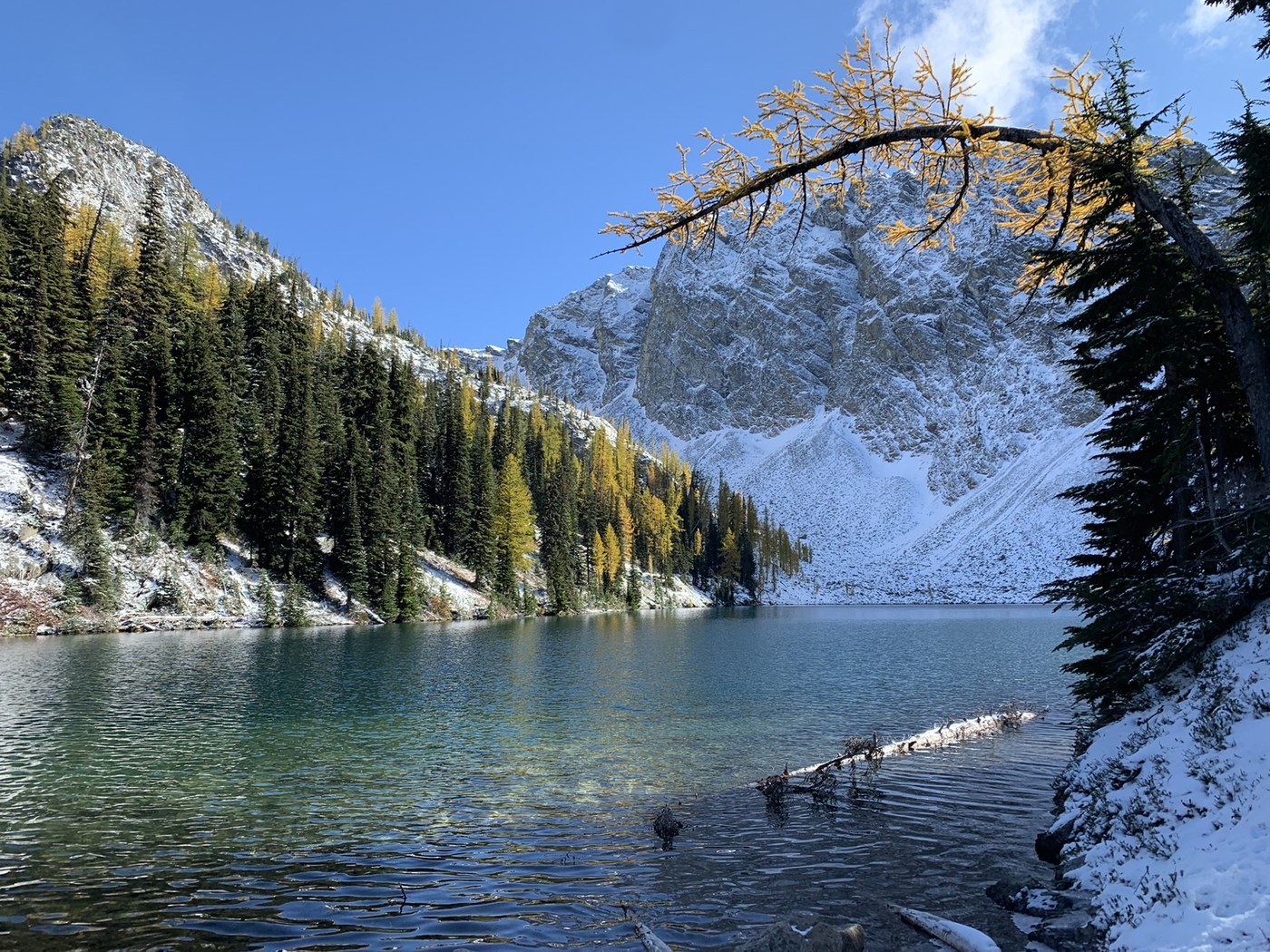
Difficulty: Moderate
Blue Lake stands out as the perfect introduction to North Cascades beauty, delivering stunning alpine scenery with surprisingly modest effort. The trail begins with gentle boardwalks before emerging into wildflower meadows that frame the Liberty Bell Group and Early Winters Spire.
The pristine alpine lake at 6,254 feet offers gin-clear water perfect for polar bear plunges, though the glacially-fed temperatures will take your breath away.
What makes Blue Lake exceptional is its accessibility – no treacherous forest roads or technical scrambling required, just a straightforward trail to one of Washington’s most photogenic alpine settings. Mountain goats frequent the surrounding talus slopes, and the fall larch display transforms the landscape into golden splendor during the first two weeks of October.
Check out the full trail guide on WTA.
Post-hike fuel stop: Make your way to Up River Grill & Tavern in Marblemount, a local favorite that draws hungry hikers with hearty American fare and outdoor patio dining. Their salmon dinners and huckleberry ice cream have earned rave reviews, and the restaurant offers a 10% discount to guests staying at the North Cascades Inn across the street. The Sasquatch-themed gifts and welcoming atmosphere make this the perfect end to your North Cascades adventure.
For a quicker stop, the historic Mazama Store offers homemade doughnuts and serves as this remote area’s community hub – grab some baked goods and enjoy them at the outdoor picnic tables while swapping trail stories with fellow hikers.
2. Heather-Maple Pass Loop – North Cascades

Difficulty: Moderate to Challenging
This counter-clockwise loop delivers the quintessential North Cascades experience, combining dense forests, alpine meadows, pristine lakes, and extensive ridge walking with 360-degree mountain panoramas. The trail’s crown jewel is Lake Ann, reached via a short 0.6-mile detour that’s absolutely essential – this glacial tarn sits in a dramatic cirque surrounded by granite walls.
The ridge section between Heather and Maple Passes offers unparalleled views of Black Peak, the Liberty Bell Group, and endless Cascade summits stretching to the horizon. During peak wildflower season in late July and August, the meadows explode with Indian paintbrush, lupine, and penstemon.
Fall transforms this hike into Washington’s premier larch experience, with golden needles carpeting the trail and surrounding slopes glowing amber against granite peaks.
Check out the full trail guide on WTA.
Post-hike fuel stop: Continue west to the Bavarian-themed town of Leavenworth (about 2 hours from the trailhead). Andreas Keller Restaurant serves authentic German cuisine in a cozy basement beer hall, where German-born head chef Anita prepares traditional schnitzels and imports draft beers.
For a more casual option, München Haus Bavarian Grill offers outdoor-only dining with charbroiled sausages and over 20 condiment choices – perfect for hungry hikers who don’t mind eating al fresco.
3. Lake Serene & Bridal Veil Falls – Central Cascades
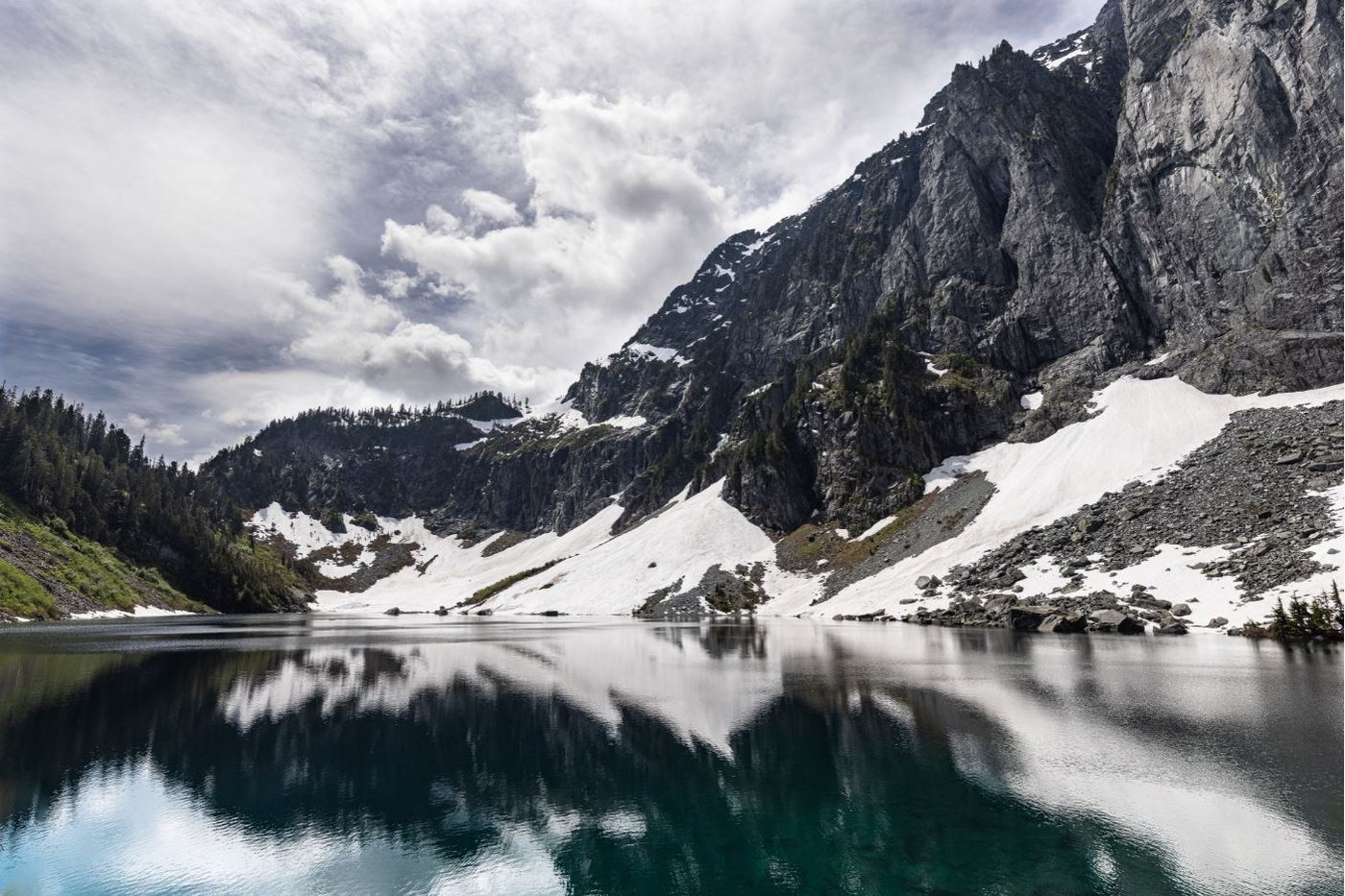
Difficulty: Challenging
This trail delivers the double payoff of a seven-tiered 1,300-foot waterfall plus a pristine alpine lake reflecting Mount Index’s dramatic 3,000-foot cliff face. The Bridal Veil Falls section features multiple wooden staircases leading to viewing platforms where you can experience the thundering cascade up close, with rainbow displays appearing in the mist during optimal lighting.
After crossing the bridge below the falls, the trail launches into 23 steep switchbacks gaining 1,500 feet in 1.8 miles – the most challenging section that separates casual hikers from those reaching Lake Serene. “Lunch Rock” at the lake provides the perfect granite boulder for picnicking, and brave souls can leap into the surprisingly warm alpine waters.
The lake’s unique feature is Mount Index’s vertical walls rising directly from the water, creating an amphitheater setting unlike anywhere else in Washington.
Check out the full trail guide on WTA.
Post-hike fuel stop: Stop at the Cascadia Inn in Skykomish for American pub fare in a rustic mountain setting that’s been serving hikers for decades. Their cafe offers breakfast, lunch, and dinner with fresh, locally-sourced ingredients – some grown in their own garden. The cozy dining room provides views of the historic railroad, and the friendly staff makes this a perfect recovery spot after those 23 switchbacks.
4. Mount Si – Snoqualmie Valley
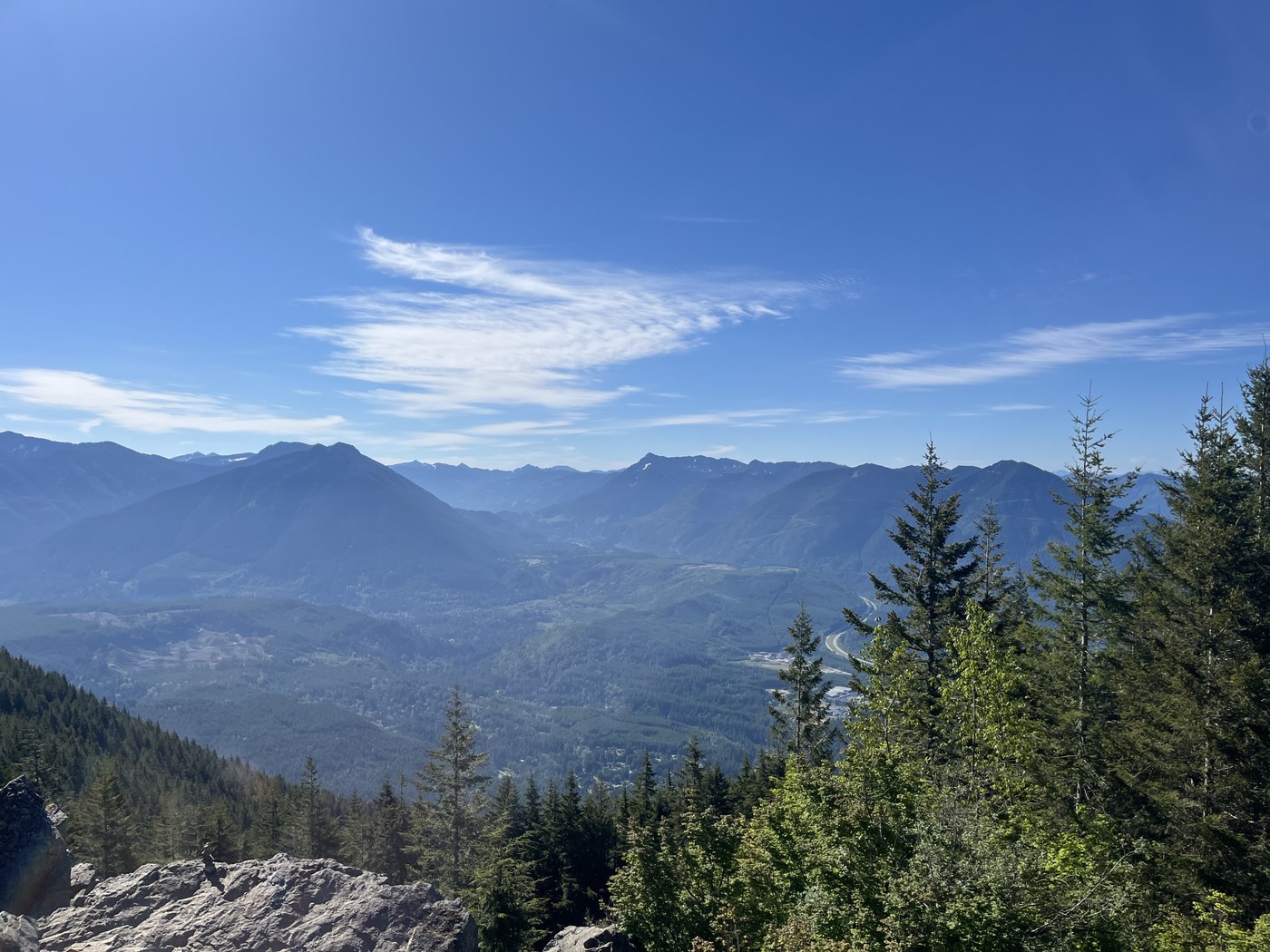
Difficulty: Challenging
Washington’s ultimate training ground challenges hikers with relentless elevation gain while delivering spectacular panoramic views of the Snoqualmie Valley, Seattle skyline, and surrounding peaks. This accessible-yet-demanding trail attracts more than 100,000 visitors annually, making it Washington’s most popular hiking destination.
The trail’s hidden gem is Snag Flat at mile 2, featuring remarkable old-growth Douglas firs and cedars that survived both historic fires and logging.
The final approach crosses extensive talus slopes with stone steps cemented into rock, leading to the main overlook with commanding views across Western Washington.
Check out the full trail guide on WTA.
Post-hike fuel stop: Head into downtown North Bend for a well-deserved meal at Twede’s Cafe, famously featured in Twin Peaks and home to “damn fine pie” – their cherry pie and coffee combo has achieved legendary status among Mount Si regulars. For craft beer enthusiasts, Volition Brewing offers rotating taps and wood-fired pizzas in a converted auto shop just minutes from the trailhead. Their outdoor patio welcomes muddy boots and tired hikers.
5. Hurricane Hill – Olympic National Park
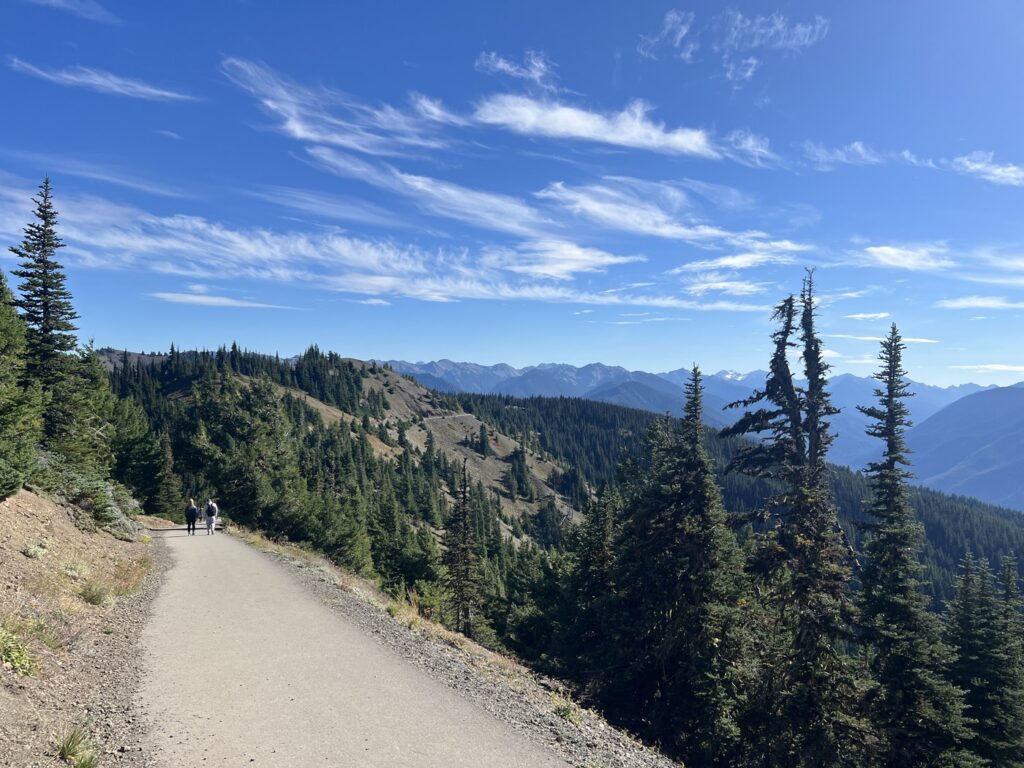
Difficulty: Easy to Moderate
Hurricane Hill provides Olympic National Park’s premier 360-degree mountain vista via a completely paved trail. From Hurricane Ridge, this accessible path winds through subalpine meadows to a 5,757-foot summit offering views of the Bailey Range, Mount Olympus, Port Angeles, Strait of Juan de Fuca, and Vancouver Island on clear days.
The fully paved surface makes this trail uniquely accessible, with the first 0.2 miles wheelchair-friendly. Three generous switchbacks lead to the summit, where visitors can literally watch ferries crossing between the US and Canada.
The Hurricane Hill name proves apt – bring wind-resistant layers as summit conditions can be dramatically different from the trailhead. Wildflower displays peak in July, carpeting the surrounding meadows with lupine, Indian paintbrush, and mountain asters.
Check out the full trail guide on WTA.
Post-hike fuel stop: Descend into Port Angeles for a meal at Next Door Gastropub, where locally-sourced ingredients shine in dishes like Dungeness crab mac and cheese. Their rotating craft beer selection includes many Washington breweries perfect for toasting your summit success.
For a unique experience, stop at Alder Wood Bistro in Sequim on your drive back – their wood-fired planked seafood and gourmet pizzas use organic ingredients from Olympic Peninsula farms, and the outdoor seating area welcomes hikers.
6. Lower Lena Lake – Olympic National Forest
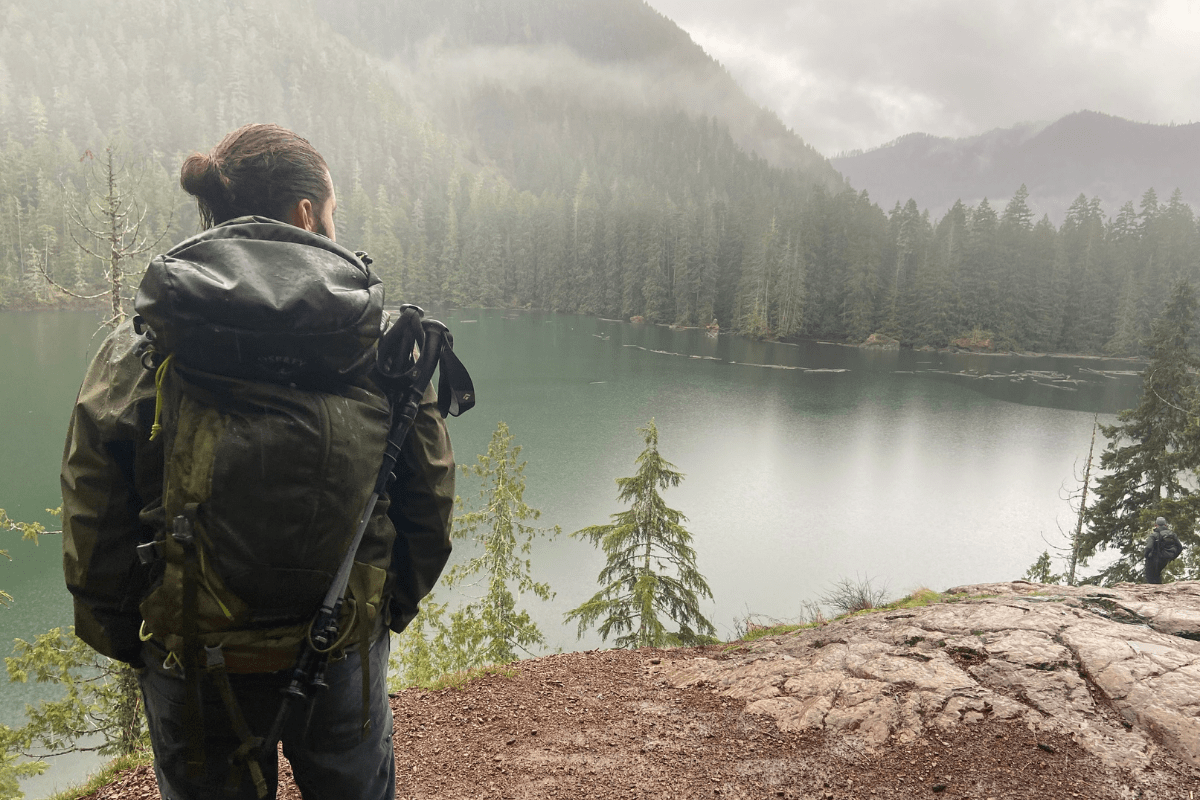
Difficulty: Moderate
Lower Lena Lake offers a quintessential Olympic National Forest experience, rewarding hikers with a stunning lakeside vista after a manageable trek through classic Pacific Northwest old-growth forest. The well-maintained trail climbs 1,300 feet over 3.6 miles to the lake, making it an accessible adventure for most hikers, including families and those newer to the trail.
The path begins with a series of gentle switchbacks, gradually becoming steeper as it winds through a lush forest of towering fir and hemlock trees. Numerous small streams and waterfalls cascade across the trail, with sturdy bridges ensuring dry passage and offering picturesque photo opportunities. About a mile in, the forest transitions to more impressive old-growth, and hikers should keep an eye out for a massive glacial erratic boulder.
At the three-mile mark, a fork to the right leads to a stunning overlook, providing the perfect panoramic view of the expansive Lena Lake, ringed by majestic, silent trees—an ideal spot for a lunch break and to soak in the scenery.
Check out the full trail guide on WTA.
Post-hike fuel stop: For a casual and satisfying meal, stop at the Burger Stand in Hoodsport, a local favorite known for its delicious, classic burgers, fries, and milkshakes. If you’re in the mood for a sit-down meal with a view, the Hoodsport Pizzeria offers a variety of pizzas and other Italian fare right on the shores of the Hood Canal.
Further down Highway 101, the historic Hama Hama Oyster Saloon provides a quintessential Washington experience with fresh, grilled oysters and other seafood in a rustic, outdoor setting right by their oyster beds.
7. Mount Ellinor – Olympic National Forest

Difficulty: Challenging
As the southernmost peak on the eastern front of the Olympics, Mount Ellinor offers a challenging and rewarding climb with unforgettable panoramic views. Hikers can choose their own adventure with two different starting points: a 6.2-mile roundtrip hike from the lower trailhead that begins with a gentle grade through old-growth forest, or a significantly steeper 3.2-mile roundtrip from the upper trailhead that gains 2,444 feet in just 1.6 miles to the summit.
Both routes eventually merge and continue on a “character-building” ascent with numerous switchbacks and stairsteps. As the trail breaks out of the tree line, it traverses rock-strewn slopes and gravelly meadows, offering ever-expanding views of Lake Cushman and the southern Olympics.
The 5,944-foot summit provides a true 360-degree vista and is a popular spot for salt-seeking mountain goats, offering a unique wildlife encounter at the top.
Check out the full trail guide on WTA.
Post-hike fuel stop: As mentioned in the last section, The Burger Stand, Hoodsport Pizzeria, and Hama Hama Oyster Saloon are all in or near Hoodsport on the way back. Alternatively, you can stop by the Model T Pub and Grill, offering hearty pub fare and a selection of beers on tap.
Essential Planning Tips
Parking: Most trailheads fill between 7-9 AM on weekends, with larch season creating 2+ mile lines of roadside parking at North Cascades locations. Weekday hiking dramatically reduces crowds while providing identical scenery. Plan to get there early and never park where you’re not supposed to.
Research: Look up trail information, recent trail reports, weather, and closures before you leave. It’s also good to know your limits and choose hikes that won’t push you beyond them. Use websites like AllTrails, Washington Trails Association (wta.org), and the National Park Service websites for current conditions and recent trip reports from other hikers.
Check road conditions through WSDOT for seasonal closures, especially on North Cascades Highway (SR-20) which typically closes from November through April.
Pass requirements:
- North Cascades and Central Cascades trails: Northwest Forest Pass ($5 daily, $30 annual)
- Olympic and Mount Rainier National Parks: National Park Pass ($30 for 7 days)
- Mount Si: Washington State Discover Pass ($35 annual)
- The America the Beautiful Annual Pass ($80) covers all federal recreation areas and is the best value for frequent hikers
Weather preparedness: Mountain conditions change rapidly regardless of valley forecasts. Always pack layers, rain gear, and extra food even for day hikes. Snow can persist at higher elevations well into July, and afternoon thunderstorms are common in summer. Check current trail conditions before departing, especially for North Cascades trails where seasonal road closures affect access.
Leave No Trace principles: Help preserve these incredible landscapes for future generations by following Leave No Trace guidelines. Visit lnt.org for complete principles, but key practices include: pack out all trash (including toilet paper), stay on designated trails, camp only in established sites, respect wildlife by observing from distance, and be considerate of other visitors.
Safety essentials: Always carry the 10 essentials: navigation tools, sun protection, first aid supplies, knife/multi-tool, fire starter, emergency shelter, extra food, extra water, extra clothes, and headlamp/flashlight. Cell service is spotty or nonexistent on most trails, so inform someone of your hiking plans and expected return time.
Seasonal Considerations:
- Spring (April-June): Snow lingers at higher elevations; microspikes often necessary
- Summer (July-September): Peak season with warmest weather but heaviest crowds
- Fall (September-November): Spectacular larch displays but unpredictable weather
- Winter (December-March): Many high-elevation trails inaccessible; North Cascades Highway closed seasonally
Trail etiquette: Yield to uphill hikers, keep dogs leashed where required, and maintain quiet voices to preserve the wilderness experience for others. Many trails prohibit dogs in national park sections—check regulations before bringing pets.
Water and food: Bring more water than you think you need—dehydration is a leading cause of hiking fatigue. Water sources may be unreliable, especially late in the season. Pack high-energy snacks and a substantial lunch for longer hikes. Consider a water filtration system for multi-day adventures.
Emergency preparedness: Download offline maps to your phone as backup navigation. Know how to use basic first aid for common hiking injuries like sprains and cuts. Consider carrying a personal locator beacon (PLB) or satellite communicator for remote trails, especially when hiking solo.




